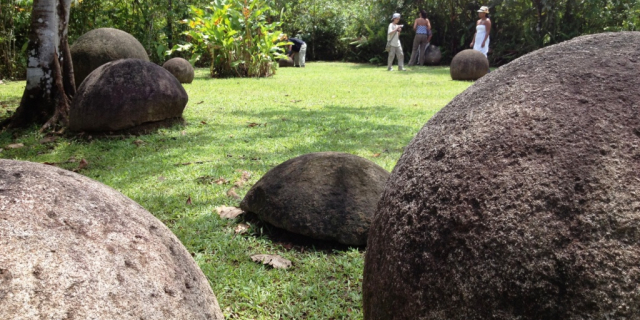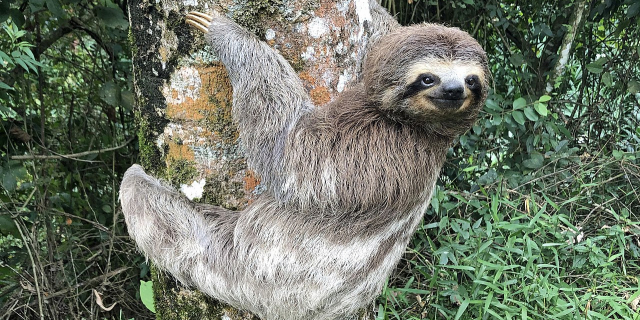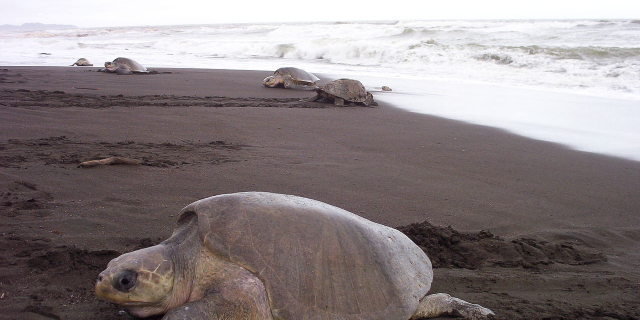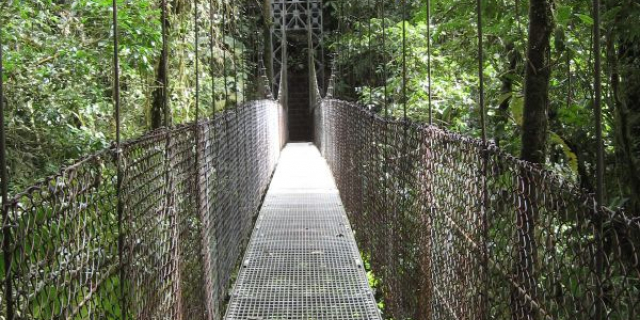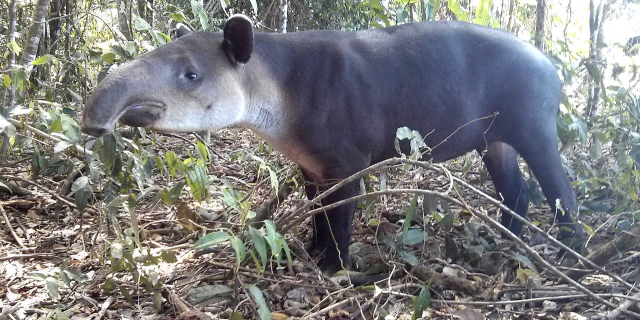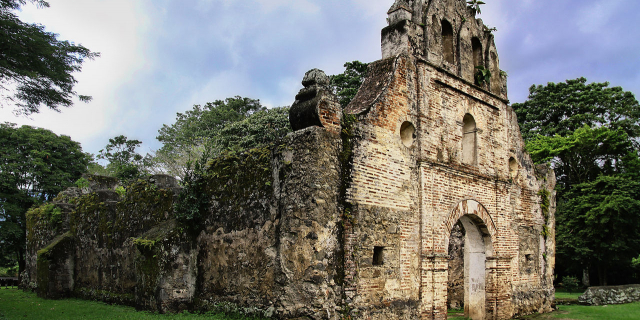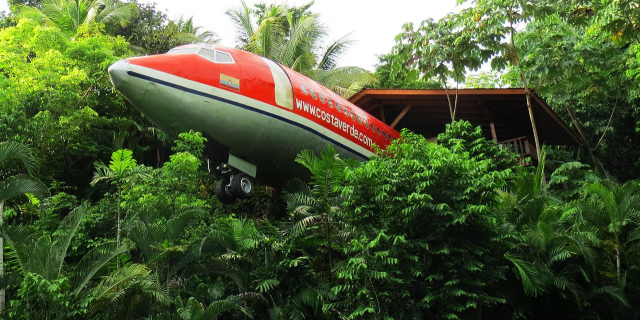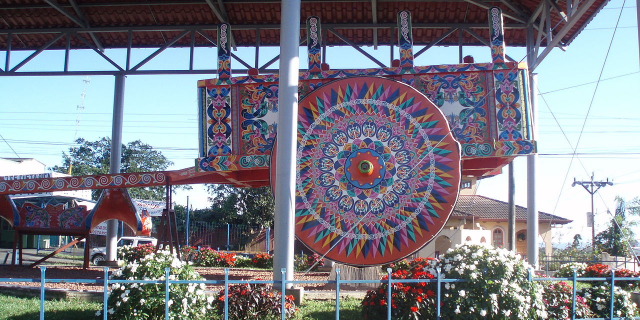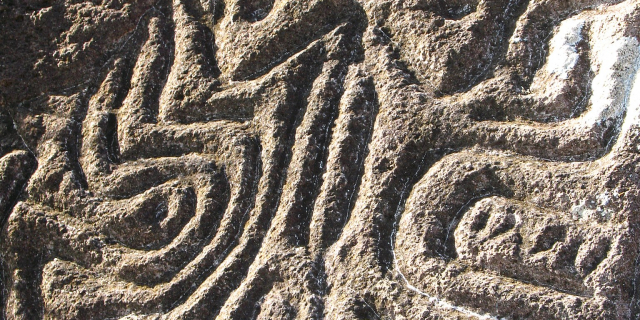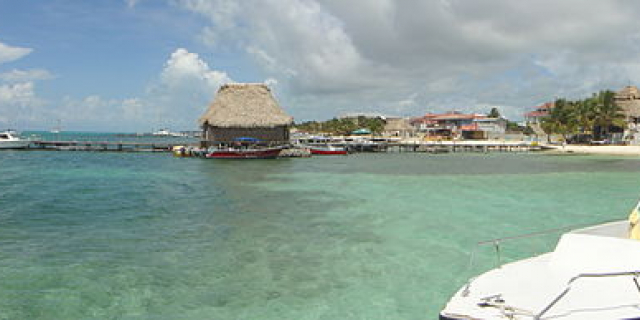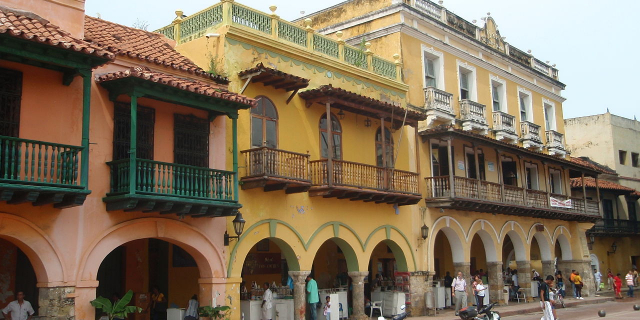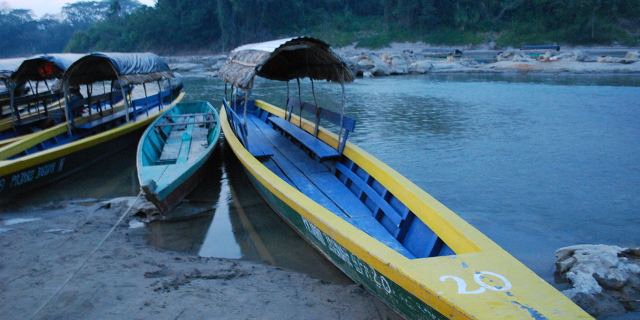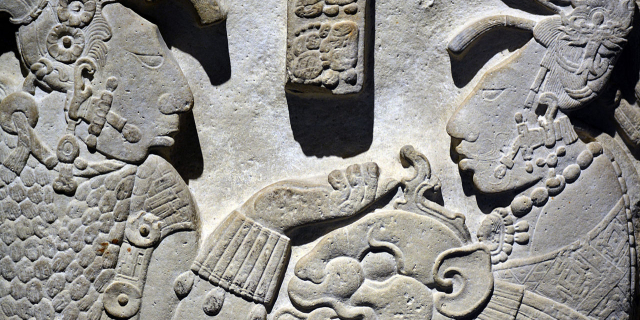Costa Rica
Context of Costa Rica
Costa Rica (UK: , US: (listen); Spanish: [ˈkosta ˈrika]; literally "Rich Coast"), officially the Republic of Costa Rica (Spanish: República de Costa Rica), is a country in the Central American region of North America, bordered by Nicaragua to the north, the Caribbean Sea to the northeast, Panama to the southeast, the Pacific Ocean to the southwest, and maritime border with Ecuador to the south of Cocos Island. It has a population of around five million in a land area of 51,060 km2 (19,710 sq mi). An estimated 333,980 people live in the capital and largest city, San José, with around two million people in the sur...Read more
Costa Rica (UK: , US: (listen); Spanish: [ˈkosta ˈrika]; literally "Rich Coast"), officially the Republic of Costa Rica (Spanish: República de Costa Rica), is a country in the Central American region of North America, bordered by Nicaragua to the north, the Caribbean Sea to the northeast, Panama to the southeast, the Pacific Ocean to the southwest, and maritime border with Ecuador to the south of Cocos Island. It has a population of around five million in a land area of 51,060 km2 (19,710 sq mi). An estimated 333,980 people live in the capital and largest city, San José, with around two million people in the surrounding metropolitan area.
The sovereign state is a unitary presidential constitutional republic. It has a long-standing and stable democracy and a highly educated workforce. The country spends roughly 6.9% of its budget (2016) on education, compared to a global average of 4.4%. Its economy, once heavily dependent on agriculture, has diversified to include sectors such as finance, corporate services for foreign companies, pharmaceuticals, and ecotourism. Many foreign manufacturing and services companies operate in Costa Rica's Free Trade Zones (FTZ) where they benefit from investment and tax incentives.
Costa Rica was inhabited by indigenous peoples before coming under Spanish rule in the 16th century. It remained a peripheral colony of the empire until independence as part of the First Mexican Empire, followed by membership in the Federal Republic of Central America, from which it formally declared independence in 1847. Following the brief Costa Rican Civil War in 1948, it permanently abolished its army in 1949, becoming one of only a few sovereign nations without a standing army.
The country has consistently performed favorably in the Human Development Index (HDI), placing 58th in the world as of 2022, and fifth in Latin America. It has also been cited by the United Nations Development Programme (UNDP) as having attained much higher human development than other countries at the same income levels, with a better record on human development and inequality than the median of the region. It also performs well in comparisons of democratic governance, press freedom, subjective happiness and sustainable wellbeing. It has the 8th freest press according to the Press Freedom Index, it is the 35th most democratic country according to the Freedom in the World index and is the 23rd happiest country in the 2023 World Happiness Report.
More about Costa Rica
- Currency Costa Rican colón
- Native name Costa Rica
- Calling code +506
- Internet domain .cr
- Mains voltage 120V/60Hz
- Democracy index 8.16
- Population 5044197
- Area 51100
- Driving side right
- Pre-Columbian period
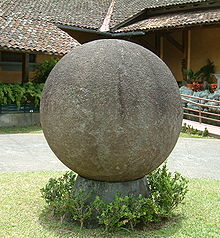 A stone sphere created by the Diquis culture at the National Museum of Costa Rica. The sphere is the icon of the country's cultural identity.
A stone sphere created by the Diquis culture at the National Museum of Costa Rica. The sphere is the icon of the country's cultural identity.Historians have classified the indigenous people of Costa Rica as belonging to the Intermediate Area, where the peripheries of the Mesoamerican and Andean native cultures overlapped. More recently, pre-Columbian Costa Rica has also been described as part of the Isthmo-Colombian Area.
...Read moreRead lessPre-Columbian period A stone sphere created by the Diquis culture at the National Museum of Costa Rica. The sphere is the icon of the country's cultural identity.
A stone sphere created by the Diquis culture at the National Museum of Costa Rica. The sphere is the icon of the country's cultural identity.Historians have classified the indigenous people of Costa Rica as belonging to the Intermediate Area, where the peripheries of the Mesoamerican and Andean native cultures overlapped. More recently, pre-Columbian Costa Rica has also been described as part of the Isthmo-Colombian Area.
Stone tools, the oldest evidence of human occupation in Costa Rica, are associated with the arrival of various groups of hunter-gatherers about 10,000 to 7,000 years BCE in the Turrialba Valley. The presence of Clovis culture type spearheads and arrows from South America opens the possibility that, in this area, two different cultures coexisted.[1]
Agriculture became evident in the populations that lived in Costa Rica about 5,000 years ago. They mainly grew tubers and roots. For the first and second millennia BCE there were already settled farming communities. These were small and scattered, although the timing of the transition from hunting and gathering to agriculture as the main livelihood in the territory is still unknown.[2]
The earliest use of pottery appears around 2,000 to 3,000 BCE. Shards of pots, cylindrical vases, platters, gourds, and other forms of vases decorated with grooves, prints, and some modeled after animals have been found.[3]
The impact of indigenous peoples on modern Costa Rican culture has been relatively small compared to other nations since the country lacked a strong native civilization, to begin with. Most of the native population was absorbed into the Spanish-speaking colonial society through inter-marriage, except for some small remnants, the most significant of which are the Bribri and Boruca tribes who still inhabit the mountains of the Cordillera de Talamanca, in the southeastern part of Costa Rica, near the frontier with Panama.
Spanish colonizationThe name la costa rica, meaning "rich coast" in the Spanish language, was in some accounts first applied by Christopher Columbus, who sailed to the eastern shores of Costa Rica during his final voyage in 1502,[4] and reported vast quantities of gold jewelry worn by natives.[5] The name may also have come from conquistador Gil González Dávila, who landed on the west coast in 1522, encountered natives, and obtained some of their gold, sometimes by violent theft and sometimes as gifts from local leaders.[6]
 The Ujarrás historical site in the Orosí Valley, Cartago province. The church was built between 1686 and 1693.
The Ujarrás historical site in the Orosí Valley, Cartago province. The church was built between 1686 and 1693.During most of the colonial period, Costa Rica was the southernmost province of the Captaincy General of Guatemala, nominally part of the Viceroyalty of New Spain. In practice, the captaincy general was a largely autonomous entity within the Spanish Empire. Costa Rica's distance from the capital of the captaincy in Guatemala, its legal prohibition under mercantilist Spanish law from trade with its southern neighbor Panama, then part of the Viceroyalty of New Granada (i.e. Colombia), and lack of resources such as gold and silver, made Costa Rica into a poor, isolated, and sparsely-inhabited region within the Spanish Empire.[7] Costa Rica was described as "the poorest and most miserable Spanish colony in all America" by a Spanish governor in 1719.[8]
Another important factor behind Costa Rica's poverty was the lack of a significant indigenous population available for encomienda (forced labor), which meant most of the Costa Rican settlers had to work on their land, preventing the establishment of large haciendas (plantations). For all these reasons, Costa Rica was, by and large, unappreciated and overlooked by the Spanish Crown and left to develop on its own. The circumstances during this period are believed to have led to many of the idiosyncrasies for which Costa Rica has become known, while concomitantly setting the stage for Costa Rica's development as a more egalitarian society than the rest of its neighbors. Costa Rica became a "rural democracy" with no oppressed mestizo or indigenous class. It was not long before Spanish settlers turned to the hills, where they found rich volcanic soil and a milder climate than that of the lowlands.[9]
IndependenceLike the rest of Central America, Costa Rica never fought for independence from Spain. On 15 September 1821, after the final Spanish defeat in the Mexican War of Independence (1810–1821), the authorities in Guatemala declared the independence of all of Central America. That date is still celebrated as Independence Day in Costa Rica[10] even though, technically, under the Spanish Constitution of 1812 that had been readopted in 1820, Nicaragua and Costa Rica had become an autonomous province with its capital in León.
Upon independence, Costa Rican authorities faced the issue of officially deciding the future of the country. Two bands formed, the Imperialists, defended by Cartago and Heredia cities which were in favor of joining the Mexican Empire, and the Republicans, represented by the cities of San José and Alajuela who defended full independence. Because of the lack of agreement on these two possible outcomes, the first civil war of Costa Rica occurred. The Battle of Ochomogo took place on the Hill of Ochomogo, located in the Central Valley in 1823. The conflict was won by the Republicans and, as a consequence, the city of Cartago lost its status as the capital, which moved to San José.[11][12][13]
 The 1849 national coat of arms was featured in the first postal stamp issued in 1862.
The 1849 national coat of arms was featured in the first postal stamp issued in 1862.In 1838, long after the Federal Republic of Central America ceased to function in practice, Costa Rica formally withdrew and proclaimed itself sovereign. The considerable distance and poor communication routes between Guatemala City and the Central Plateau, where most of the Costa Rican population lived then and still lives now, meant the local population had little allegiance to the federal government in Guatemala. Since colonial times, Costa Rica has been reluctant to become economically tied with the rest of Central America. Even today, despite most of its neighbors'[a] efforts to increase regional integration,[14] Costa Rica has remained more independent.
Until 1849, when it became part of Panama, Chiriquí was part of Costa Rica. Costa Rican pride was assuaged for the loss of this eastern (or southern) territory with the acquisition of Guanacaste, in the north.
Economic growth in the 19th centuryCoffee was first planted in Costa Rica in 1808,[15] and by the 1820s, it surpassed tobacco, sugar, and cacao as a primary export. Coffee production remained Costa Rica's principal source of wealth well into the 20th century, creating a wealthy class of growers, the so-called Coffee Barons.[16] The revenue helped to modernize the country.[17][18]
Most of the coffee exported was grown around the main centers of population in the Central Plateau and then transported by oxcart to the Pacific port of Puntarenas after the main road was built in 1846.[18] By the mid-1850s the main market for coffee was Britain.[19] It soon became a high priority to developing an effective transportation route from the Central Plateau to the Atlantic Ocean. For this purpose, in the 1870s, the Costa Rican government contracted with U.S. businessman Minor C. Keith to build a railroad from San José to the Caribbean port of Limón. Despite enormous difficulties with construction, disease, and financing, the railroad was completed in 1890.[20]
Most Afro-Costa Ricans descend from Jamaican immigrants who worked in the construction of that railway and now make up about 3% of Costa Rica's population.[citation needed] U.S. convicts, Italians, and Chinese immigrants also participated in the construction project. In exchange for completing the railroad, the Costa Rican government granted Keith large tracts of land and a lease on the train route, which he used to produce bananas and export them to the United States. As a result, bananas came to rival coffee as the principal Costa Rican export, while foreign-owned corporations (including the United Fruit Company later) began to hold a major role in the national economy and eventually became a symbol of the exploitative export economy.[21] The major labor dispute between the peasants and the United Fruit Company (The Great Banana Strike) was a major event in the country's history and was an important step that would eventually lead to the formation of effective trade unions in Costa Rica, as the company was required to sign a collective agreement with its workers in 1938.[22][23]
20th centuryHistorically, Costa Rica has generally enjoyed greater peace and more consistent political stability than many of its fellow Latin American nations. Since the late 19th century, however, Costa Rica has experienced two significant periods of violence. In 1917–1919, General Federico Tinoco Granados ruled as a military dictator until he was overthrown and forced into exile. The unpopularity of Tinoco's regime led, after he was overthrown, to a considerable decline in the size, wealth, and political influence of the Costa Rican military. In 1948, José Figueres Ferrer led an armed uprising in the wake of a disputed presidential election between Rafael Ángel Calderón Guardia (who had been president between 1940 and 1944) and Otilio Ulate Blanco.[24] With more than 2,000 dead, the resulting 44-day Costa Rican Civil War was the bloodiest event in Costa Rica during the 20th century.
The victorious rebels formed a government junta that abolished the military altogether and oversaw the drafting of a new constitution by a democratically elected assembly.[25] Having enacted these reforms, the junta transferred power to Ulate on 8 November 1949. After the coup d'état, Figueres became a national hero, winning the country's first democratic election under the new constitution in 1953. Since then, Costa Rica has held 15 additional presidential elections, the latest in 2022. With uninterrupted democracy dating back to at least 1948, the country is the region's most stable.[26][27]
^ Botey Sobrado, Ana María (2002). Costa Rica: estado, economía, sociedad y cultura desde las sociedades autóctonas hasta 1914 (in Spanish) (2a ed.). Editorial Universidad de Costa Rica. pp. 30–31. OCLC 51817062. ^ Botey Sobrado 2002, p. 32 ^ Botey Sobrado 2002, pp. 32–33 ^ "About Costa Rica". Embassy of Costa Rica in Washington DC. Retrieved 18 September 2012. ^ "History of Costa Rica". Lonely Planet. Retrieved 18 September 2012. ^ Rojas, Eugenia Ibarra (2001). Fronteras etnicas en la conquista de Nicaragua y Nicoya: entre la solidaridad y el conflicto 800 d.C.-1544. Universidad de Costa Rica. ISBN 9789977676852. ^ Claudia Quirós. La Era de la Encomienda. Historia de Costa Rica. Editorial de la Universidad de Costa Rica. 1990. ^ Shafer, D. Michael (1994). Winners and losers: how sectors shape the developmental prospects of states. Ithaca, N.Y.: Cornell University Press. ISBN 978-0-8014-8188-8. ^ "Costa Rica – Cartago". Costarica.com. 22 May 2009. Archived from the original on 22 February 2008. Retrieved 26 June 2010. ^ "Aniversario de la Independencia Nacional". Ministerio de Educación Pública (in Spanish). Retrieved 13 September 2018. ^ Cartilla Histórica de Costa Rica. EUNED. 2005. ISBN 9789968313759. ^ Alarmvogel (1966). Apuntes para la historia de la ciudad de Alajuela. San José, Costa Rica: Impr. Nacional. OCLC 14462048. ^ Obregón Loría, Rafael. "Hechos Militares y Políticos de Nuestra Historia Patria". Museo Histórico Cultural Juan Santamaría, Costa Rica, 1981. ^ "Central America". www.cotf.edu. Archived from the original on 2 August 2017. Retrieved 12 August 2017. ^ "Costa Rica's Coffee Tradition – Costa Rica Star News". 21 October 2016. ^ "Coffee of Costa Rica – el café". www.travelcostarica.nu. Archived from the original on 13 August 2017. Retrieved 12 August 2017. ^ "History of Coffee in Costa Rica". Embajada de Costa Rica en Singapur. ^ a b Imports, Cafe. "Cafe Imports – Costa Rica". www.cafeimports.com. ^ "Costa Rica Coffee – Past & Present Coffee Cultivations". www.anywhere.com. ^ "Coffee Production and Processing on a Large Costa Rican Finca". Bib. Orton IICA / CATIE – via Google Books. ^ Rankin, Monica A. (29 December 2017). The History of Costa Rica. ABC-CLIO. ISBN 9780313379444 – via Google Books. ^ Bucheli, Marcelo (1 February 2005). Bananas and Business: The United Fruit Company in Colombia, 1899–2000. NYU Press. ISBN 9780814769874 – via Google Books. ^ Shafer, D. Michael (29 December 1994). Winners and Losers: How Sectors Shape the Developmental Prospects of States. Cornell University Press. p. 213. ISBN 978-0801481888 – via Internet Archive. ^ See Ian Holzhauer, "The Presidency of Calderón Guardia" (University of Florida History Thesis, 2004) ^ Cite error: The named reference nytimes-military was invoked but never defined (see the help page). ^ Cite error: The named reference peace was invoked but never defined (see the help page). ^ Cite error: The named reference pacifism was invoked but never defined (see the help page).
Cite error: There are <ref group=lower-alpha> tags or {{efn}} templates on this page, but the references will not show without a {{reflist|group=lower-alpha}} template or {{notelist}} template (see the help page).
- Stay safe
 Mounted police officers
Mounted police officers
Travel to Costa Rica is common, with 1.9 million people visiting annually, more than any other Latin American country. Costa Rica is generally regarded to be one of the less crime-ridden and more politically stable countries in Latin America. Still, travellers to Costa Rica should exercise caution. The emergency number in Costa Rica is 911.
...Read moreStay safeRead less Mounted police officers
Mounted police officers
Travel to Costa Rica is common, with 1.9 million people visiting annually, more than any other Latin American country. Costa Rica is generally regarded to be one of the less crime-ridden and more politically stable countries in Latin America. Still, travellers to Costa Rica should exercise caution. The emergency number in Costa Rica is 911.
Traffic in Costa Rica is dangerous. Pedestrians in general do not have the right of way. Roads in rural areas may also tend to have many potholes. Driving at night is not recommended. Use common sense. Do not leave valuables in plain view in a car or leave your wallet on the beach when going into the water. Close the car windows and lock the car or other things that you might not do in your own country. In the cities, robbery at knife point is not uncommon. Buses and bus stops - especially those destined for San José - are frequent locations for robbery. Any bus rider who falls asleep has a good chance of waking up and finding his baggage missing. Don't trust anyone on the buses to watch your things, especially near San José. Watch out for pickpockets. Purse snatchings, armed robberies, and car-jackings have been on the rise lately. Stay alert and protect your valuables at all times, especially in the San José area. "Smash and grabs" of car windows are very common all over the country so do not leave valuables in your vehicle. Another robbery scheme involves slashing your tires; when you stop to fix the flat, one or two "friendly" people stop to help and instead grab what valuables they can. If you are motioned to pull over by anyone, do not do so until you are at a well-lit and safe place. Make use of hostel or hotel lock boxes if they are really secure – this is great when you want to swim or relax and really not worry. On a long trip, make back-up CDs (or DVDs) of your digital photos and send a copy back home. In the event that you are robbed, you will thank yourself. Or upload them to a cloud storage service. Travel with small denominations of U.S. dollars (crisp ones, fives, tens) as back-up. Usually, you'll be able to use them if you run out of local currency. Go to a bank to change money when possible. If you find yourself needing to use the services of a private money changer (Sunday morning at the border, for instance) use your phone to do the calculations. Do not trust money changers and their doctored calculators, change the least amount of money possible and take a hard look at the bills – there are lots of false ones. Always insist that your change be in small bills – you'll lose more at one time if a large bill is false, and large bills are hard to change (even the equivalent of US$20 in Costa Rica or US$5 in Nicaragua can be difficult in some small towns) Money changers do not use the official exchange rate - you are better off going to a state-owned bank to exchange your currency at no fee. Also, it's impossible to change Brazilian reals, although there are a lot of Brazilian tourists in Costa Rica. Do not exchange money when arriving at the San José airport. The exchange rate used there is not the official rate and you will get a lot fewer colones. However, the departure hall upstairs has a BCR bank with normal exchange rates. It is right next to the departure tax payment area, buy when you arrive to avoid the queue on departure. Travelling alone is fine and generally safe in Costa Rica, but carefully consider what kind of risks (if any) you are willing to take. Always hike with other people and try to explore a new city with other people. On solo forays, if you feel uncomfortable seek out a group of other people (both women and men). A well lighted place with people you can trust is always a plus. A busy restaurant or hostel is a great source of local info as well as a great place to relax and recharge.NarcoticsCannabis traffic, distribution, and commerce is illegal in Costa Rica. There is no penalty when you carry small cannabis quantities for personal use only (up to three joints) and police could try to get money from you or keep you in the local commissary for up to 12 hours. U.S. Drug Enforcement Administration personnel are present in Costa Rica and have been known to pretend to be tourists. There is a Costa Rican equivalent of the DEA as well. Do not use illegal drugs in Costa Rica, nor should you try to bribe a police officer.
ProstitutionProstitution is legal in Costa Rica and can be a destination for those looking for sex on their vacation.
Prostitution with minors (less than 18 years old) is a crime. The majority of sex tourists are from the United States, and if they engage in prostitution with a minor, are prosecutable by the U.S. Protect Act of 2003. This act gives the U.S. government the power to prosecute its citizens who travel abroad to engage in sex tourism with children under the age of 18. Several other countries including France, Canada, the United Kingdom, Germany, Netherlands, and Australia have similar laws. Arrests, warrants, and prosecutions are performed under these laws.
Bus travel tipsBelow is a list of suggestions for travelling by bus in Costa Rica and neighboring countries. These are overcautious tips, but they can help prevent problems. Nearly all thefts on the bus are preventable.
Travel with someone else when possible. A trusted friend is best, but someone you met last night at the hostel will do in a pinch. Trust your gut feeling with new friends – most are great, but some may be con artists. Wear a money belt with your passport, cash, credit/debit cards, and ticket (bus or plane). Even if all your other belongings are stolen, you would still be able to get to your next destination. The waist belts are best; a neck pouch can be lifted while you are asleep. A thief would really have to disturb you to steal from a waist belt. On the bus, try to sit above the luggage compartment so that you can watch that your bag isn't stolen when others disembark. Buses usually have one compartment for those heading to the main destination, and a separate one for people getting off along the way, to avoid problems. Watch out for the "destination" compartment being opened en route. On routes ending in San José, for example from Quepos, the bus driver will ask if you are going to the airport if he sees you have big luggage with you. Say no because they are asking this so they can call their taxi friends to pick you up at a stop before San José and drive you to the airport. Firstly, you cannot trust that this friend of his is an official taxi driver and, secondly, that they will not charge more than normal to cover the bus driver's share. If you are going to the airport, plan your trip ahead so you know exactly how to get there. Try not to fall asleep, or take turns sleeping with a travel partner (when you have one). The best way to snooze alone is with your bag on your lap and your hands crossed over it. Don't leave valuables in outside compartments. Make conversation with locals on the bus so that they can see that you are competent in Spanish and comfortable in the Spanish speaking environment. You will enjoy yourself, and this may make them feel friendly towards you and more willing to alert you if someone is eyeing your belongings. Or it might warn them that if they steal from you, you will talk to the bus driver and police and make a full report. Even some Spanish is better than none – use what you have. It's great practice and the more you improve the safer you'll be. Don't bring anything that you are not willing to lose. Keep your day pack attached to you always when travelling – wrap the straps around your leg and keep the bag squeezed between your knees or feet. Almost all thefts on buses are from the overhead bins so it is better to keep things on your lap.Beaches, weather and wildlife Surfer on beach
Surfer on beach
The coasts of Costa Rica are known for strong currents and rip-tides in some areas but most of them are great to be with the family. Costa Rica has some of the best beaches in the world. The Atlantic coast is just five hours from the Pacific coast and both offer different views and landscapes. There are no signs indicating an unsafe beach due to riptides, so take precautions and listen to the locals on where it is safe to swim. The public beaches do not have life guards. A traveller should learn how to swim out of a rip tide and not swim alone. There are some active volcanoes in Costa Rica and they are dangerous, so follow the warning signs posted. The slopes of the Arenal volcano invite visitors to climb closer to the summit, but there have been fatalities in the past with unseen gas chambers. Also be wary of the climate of Costa Rica. It is very hot in the daytime, but in the morning and evening it becomes very cool, so you should bring a light weight jacket.
Crocodiles are quite common in certain areas and, although not as dangerous as the Nile or saltwater species, are still considered occasional man-eaters and can grow to lengths of up to 20 feet. The biggest spot for them is the Tarcoles river bridge in the central Pacific, as posted in the Jaco wiki. It is recommended to stop the vehicle nearby and walk across it. Some locals throw chicken meat and watch them eat. Great care should be taken when swimming or snorkelling, especially near areas where fishing is common, or near river mouths.When you go to the Pacific beaches in Guanacaste, you can see crocodiles over the Tempisque river. The bridge across this river was donated by the Taiwanese government. (Subsequently, China donated a 35,000-seat stadium after Costa Rica ended its diplomatic recognition of Taiwan.)
While large, the beautiful jaguar is extremely rare and even most locals have never seen the very large predatory cat. They appear to be very shy and elusive; there is very little risk of attack. Sharks are a part of ocean marine life but most pose little danger to people. However, bull sharks and tiger sharks are known to inhabit local waters. Both are known to attack people. Bull sharks can swim in brackish and freshwater, sharing much of the same territory as crocodiles. Actual attacks however are extremely rare. Between 1900 and 2017 there have only been 11 unprovoked attacks on people in Costa Rica, with about half being fatal. Dogs are trained to be protective of property and people (perro bravo), and there are also many strays. Dog bites are not uncommon. Do not approach an unknown dog. Snakes are common in many parts of Costa Rica and it is believed that there are 139 different species. Most are not dangerous, but there are exceptions. The venomous ones generally fall into two groups, the first being coral snakes and the second pit vipers. Coral snakes are easily recognized by their colorful banding. They have small mouths with fangs that are ill placed for biting people. Pit vipers almost always have triangular heads but may otherwise come in different sizes and colors. Most snakes are shy and will avoid people, but may strike if frightened or provoked. Snake bites are rare in Costa Rica but do happen. The best course is prevention. If you are walking in the countryside or in the jungle watch your step and do not walk barefoot anywhere other than at the beach. If you see a snake, remember the cardinal rule when dealing with wildlife: look but don't touch, while maintaining a safe distance. If you are bitten, treat it as a medical emergency and seek immediate care, especially if you think it might be venomous. A few snakes, such as the fer-de-lance and bushmaster have extremely potent venom which can be life threatening. Costa Rica has excellent medical care, so anti-venom is readily available at all of the major hospitals.Gay and lesbian travelersCosta Rica is quite a conservative and traditionalist nation. The state's official religion is Roman Catholicism and its population is quite religious. Nevertheless, it caters to the needs of gay and lesbian travelers. There is a thriving gay scene in San José with many gay and lesbian options for night-life. The Manuel Antonio, Jacó, and Quepos area is also a favorite spot with several gay hotels and bars.
There are a good number of gay/lesbian or gay-friendly accommodations in Costa Rica. They seem to be of the higher quality offering a variety of services and of course, discretion. Many hotels, travel agencies, and resorts are run by gays or are gay-friendly.
Medical tourismAccording to the Costa Rica Tourism Board, about 200 medical procedures are performed for medical tourists every month. Among these are cosmetic surgery, knee and hip replacement, cataract removal and other eye treatments, weight loss surgery and dental care. Health care in Costa Rica is attractive for international patients because of the low prices, high care standards, and access to tourist attractions. For example, a hip replacement costs around US$12,000 and a tummy tuck costs around US$4,400.
The main medical tourism centers are CIMA Hospital, Hospital Clinica Biblica, and Hospital Hotel La Catolica. In turn, these hospitals use medical tourism facilitators who can arrange every aspect of your trip from beginning to end.










